Abstract
This study was carried out to investigate the effects of adding different rates (0, 2.5, 5.0 and 10.0 mmol kg−1) of various organic complexifying agents (OCA) [ethylene diamine tetra acetate (EDTA), diethylene triamine penta acetate (DTPA), citric acid (CA), and humic acid (HA)] on heavy metal availability in the contaminated soils with 100 mg kg−1 B (H3BO3), 400 mg kg−1 Cd (CdCl2), 10 mg kg−1 Mo (Na2MoO4 2H2O) and 100 mg kg−1 Pb(NO3)2 and on the capacity of corn (Zea mays L.) and sunflower (Helianthus annus.) plants to uptake B, Cd, Mo and Pb in heated greenhouse conditions. Corn and sunflower plants were grown at 10,000 plants ha−1. Results indicated that OCA application increased heavy metal availability and uptake by plants. The capacity of OCA to release B, Cd, Mo and Pb in soils planted with corn and sunflower were HA>CA>EDTA>DTPA and HA>EDTA>CA>DTPA, respectively. Of the OCA tested, humic acid was the most effective in enhancing B, Cd, Mo and Pb uptake in both plant species. Significant differences were obtained in both species and plant parts. Plant species tested, sunflower was the most effective in uptake of B, Cd, and Mo. Root heavy metal uptake was greater than shoot heavy metal uptake in both species. As a conclusion, it can be said that humic acid facilitated B, Cd, Mo and Pb phytoextraction may provide effective soil decontamination strategy.
Introduction
Owing to human and natural activities soils can be contaminated with heavy metals derived from various sources, including abandoned mining wastes, improper treatment of industrial wastes, incomplete collection of used batteries, leakage of landfill leachate, accidental spills and military activities (Kim et al., Citation2001). As a result groundwater may be contaminated by the leaching action of contaminated soils. Heavy metals can be transferred by the intake of vegetation, and human and animal health can be impacted through ingestion of both water and foods that have been contaminated by the soil (Lo & Yang, Citation1999).
Contaminated soils can be remediated by physical, chemical and biological techniques (McEldowney et al., Citation1993). Traditional treatments for metal contamination in soils are expensive and cost prohibitive where large areas of soils are contaminated. Treatments can be done in situ or ex situ which are both extremely expensive. They include high temperature treatments, solidifying agents and washing process (USDA & NRCS, Citation2000). Therefore, the development of cost effective and in situ environmentally technologies for the remediation of heavy metal contaminated soils is much needed.
Over the last ten years there has been increasing interest in developing a plant-based technology to remediate heavy metal contaminated soils (Elkhatib et al., Citation2001). Phytoremediation is an emerging technology that uses various plants to degrade, extract, contain or immobilize contaminants from soil and water (EPA, Citation2000). The success of phytoremediation depends on the selection of soil amendments and plant species that maximize soil contaminant removal (Elkhatib et al., Citation2001).
The solubility of heavy metals in soil is limited due to complexification with organic matter, adsorption on clays and oxides, and precipitation as carbonates, hydroxides and phosphates (McBride, Citation1994). Complexification of metals by organic complexifying agents plays an important role in controlling metal solubility (Naidu & Harter, Citation1998), and increased solubility can be achieved by adding chelates to the soil. Chelates were traditionally used in hydroponic solutions to buffer or decrease the availability of metals for uptake, while in soils they have been used to increase the availability of heavy metals for uptake by the plant and also facilitate their movement to plant roots and facilitate accumulation (Norvell, Citation1991).
Huang et al. (Citation1997) and Blaylock et al. (Citation1997) were able to achieve rapid accumulation of Pb in shoots to greater than 1% of shoot dry biomass with EDTA, the most commonly used chelating agent.
Greenhouse studies using heavy metal contaminated soil from an abandoned gold mine in Australia have shown that after a six week growth period there was enhanced uptake of Fe, Mn and Cu by Zea mays if the soil was treated with EDTA or DTPA (1 g chelator kg soil−1) prior to planting (Chaudhry unpublished results).
There is limited information on the use of CA, DTPA, EDTA and HA to enhance B, Cd, Mo and Pb accumulation in plants. Therefore, this study is carried out to compare the relative efficiency of selected organic complexifying agents in enhancing B, Cd, Mo and Pb phytoextraction and to identify soil amendments that increase B, Cd, Mo and Pb desorption from soil.
Materials and methods
A loamy (36.6% sand, 34.4% silt, and 29.0% clay) textured soil was sampled from Erzurum province (39°55′N, 41°61 E) of Turkey. The soil had 1.30% CaCO3, 300.2 mmol kg−1 P2O5, 430.3 mmol kg−1 K2O, 6.90 pH (H2O) and 1.15 dS m−1 electrical conductivity.
Soil was transferred to 20 cm diameter polyethylene pots. Each soil was treated with 100 mg kg−1 B (H3BO3), 400 mg kg−1 Cd (CdCl2), 10 mg kg−1 Mo (Na2MoO4 2H2O) and 100 mg kg−1 Pb(NO3)2 as pollutant. Actual contamination was performed by applying the correct amount of heavy metals dissolved in deionised water to each pot (3000 g soil pot−1), and these were saturated, air dried at room temperature and thoroughly mixed. The wetting-drying mixing process was repeated to insure soil equilibrium. The pollutant treated soils were fertilised with N, P, and K using urea (120 mg kg−1 N), calcium phosphate (100 mg kg−1 P), and potassium sulphate (50 mg kg−1 K). After the application of pollutants soils were treated with the following organic complexifying agents (OCA) at the rates of 0, 2.5, 5, and 10 mmol kg−1: ethylene diamine tetra acetate (EDTA), diethylene triamine penta acetate (DTPA), citric acid (CA) and humic acid (HA). Concentrations of OCA were based on upper soil surface layer and were sprayed on the soil surface, following procedures used in a previous study (Vogeler et al., Citation2001).
Plants tolerant to toxicity levels of trace elements respond by exclusion, or accumulation of metals (Baker, Citation1981). Plants are selected consistent with application requirements, contaminants of concern and species producing high-biomass. In phytoextraction, the objective is to concentrate the metals in the aerial portion of the biomass, and to harvest and recover metals from the biomass (Schnoor Citation1997). Corn (Zea mays) and sunflower (Helianthus annus) were selected from the informations given by Baker (Citation1995), Lasat (Citation2000) and EPA (Citation2000).
Plants were maintained in a heated greenhouse under natural light at a minimum temperature of 10–11°C and maximum of 25–30°C, and a relative humidity of about 30–40%. Day length was 14 h during the experimental period. Corn and sunflower seeds were germinated for five days at 25°C, with an approximate density of 10,000 plant ha−1. Three seedlings were transplanted to each pot containing 3000 g soil. The pots were weighed daily and irrigated with deionised water to replace water lost through transpiration. Water content of the soil was adjusted to 70% of field capacity. There were three replicates of each treatment, giving a total of 96 pots in a randomized block design. The plants were harvested 60 days after germination. Soils samples were collected in each pot, air-dried and sieved (2 mm mesh size) for soil analyses. Particle size distribution was determined by the method proposed by Gee & Bauder (Citation1986). Total carbonate, phosphorus, potassium, pH and electrical conductivity were determined by the methods described by Page et al. (Citation1982). Total Cd and Pb contents of soil were determined by digesting 2 g of soil in a mixture of concentrated HNO3/HCl (v:v, 1:3) (Baker & Amacher, Citation1982; Burau, Citation1982). B and Mo contents of soil were determined by digesting 1 g of soil with Na2CO3, H2SO4 and HCl (Bingham, Citation1982; Kubota & Cary, Citation1982). Digested samples were analyzed by atomic absorption spectrophotometry.
Plants were harvested by cutting the shoots from the soil surface and washed with deionised water. Plant roots were separated from the soil and washed with water until free of soil and then washed three times with deionised water. Plant shoots and roots were dried for 48 h at 70°C and were ground. Sub-samples of ground plant materials were analyzed. B, Cd, Mo and Pb were determined after wet digestion of dried and ground sub-samples in a H2SO4-Se-salicylic acid mixture. B, Cd, Mo and Pb analysis was performed by atomic absorption spectrometry (AOAC, Citation1970).
Each pot was considered as a replicate and all of the treatments were repeated three times. All data were subjected to a two way analysis of variance (ANOVA) and separated by LSD, performed using (SAS) statistical software (SAS, 1982).
Results and discussion
Dry matter yield of plants
Application of OCA to heavy metal contaminated soils significantly decreased dry matter yield of both species, and plants showed significant decrease when OCA addition levels were higher than 2.5 mmol kg−1. shows the dry matter yield of corn and sunflower plants according to the addition level of OCA.
Table 1. Effects of organic complexifying agents on dry matter weight of corn and sunflower plants (dw g pot−1)
Efficiency of organic complexifying agents in enhancing soil B, Cd, Mo and Pb desorption
Effects of OCA application significantly increased heavy metal availability in soils. Heavy metal concentration in the soil increased with increased levels of OCA added to both corn and sunflower planted soils. The ability of OCA to release B, Cd, Mo and Pb in soils planted with corn and sunflower followed the order of HA>CA>EDTA>DTPA and HA>EDTA>CA>DTPA, respectively ( –).
Fig. 1. Effects of different organic complexifying agents on B and Cd concentration in corn planted soil.
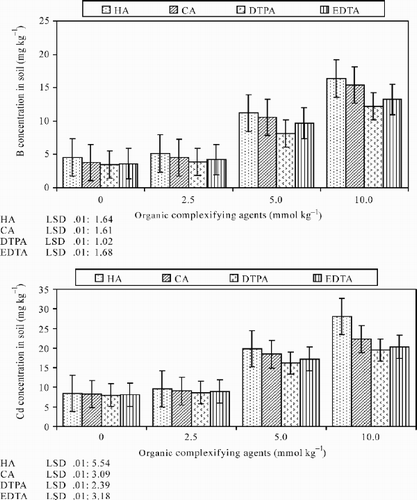
Fig. 2. Effects of different organic complexifying agents on Mo and Pb concentration in corn planted soil.
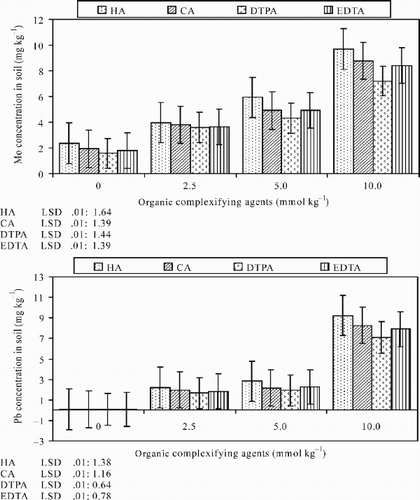
Fig. 3. Effects of different organic complexifying agents on B and Cd concentration in sunflower planted soil.
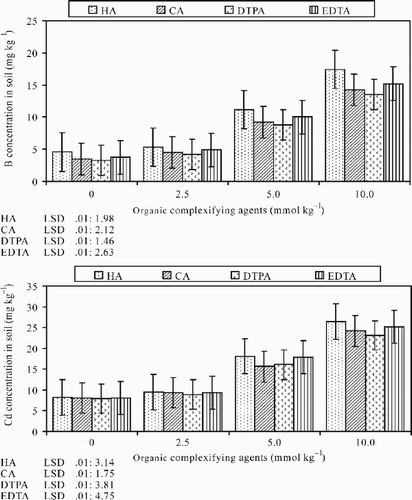
Fig. 4. Effects of different organic complexifying agents on Mo and Pb concentration in sunflower planted soil.
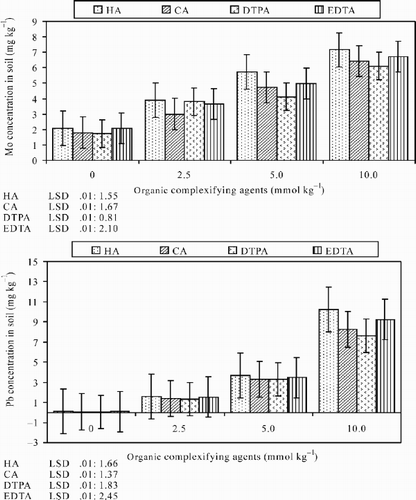
Recent studies has reported that complexation of B, Cd, Mo and Pb by different organic chelates can play an important role in controlling heavy metal solubility and concentration in soil (Naidu & Harter, Citation1998; Irenem & Yang, Citation1999). Humic acid application to soils was the most effective agent as compared to others. This might be due to the rapid biodegradation of humic acid. Rapid biodegradation of humic acid makes it an ideal soil amendment for phytoextraction of heavy metals such as B, Cd, Mo and Pb and also prevents the possible movement of heavy metal-humic acid complexes across the soil profile (Chen & Aviad Citation1990; Zhang et al., Citation2003).
Heavy metal concentration in shoots and roots
At all OCA application rates, heavy metal concentrations in roots were about 4–6 times higher than in shoots. Application of OCA at the rates of 2.5, 5.0 and 10 mmol kg−1 significantly increased heavy metal concentration in shoots and roots in both species ( –).
Fig. 5. Effects of different organic complexifying agent on B and Cd content in sunflower and corn shoots.
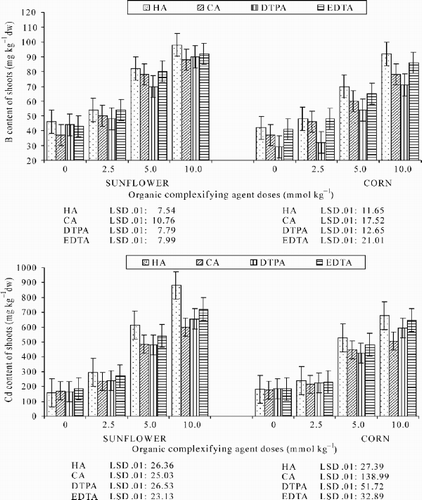
Fig. 6. Effects of different organic complexifying agent on Mo and Pb content in sunflower and corn shoots.
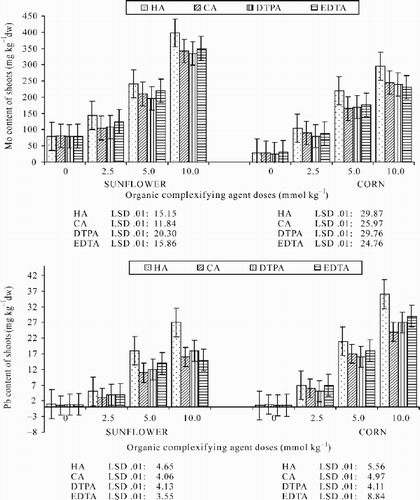
Fig. 7. Effects of different organic complexifying agent on B and Cd content in sunflower and corn roots.
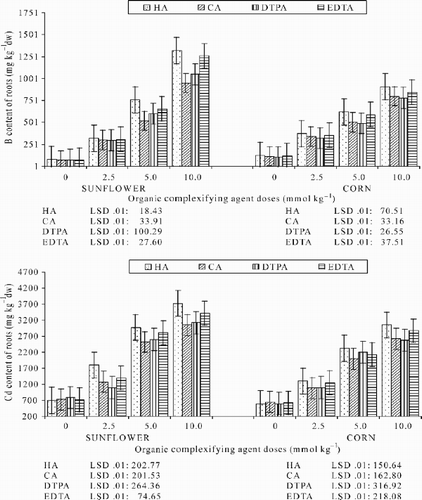
Fig. 8. Effects of different organic complexifying agent on Mo and Pb content in sunflower and corn roots.

Heavy metal concentration in shoots and roots of both species significantly increased when HA addition levels were higher than 2.5 mmol kg−1 ( –). Application of CA, DTPA, and EDTA at rates up to 5.0 mmol kg−1 significantly increased heavy metal concentration in both species; however, rates over 5.0 mmol kg−1 decreased heavy metal concentration significantly due to decreasing total dry matter weight. Of the plant species tested, sunflower was most effective in uptake of B, Cd, and Mo, but corn was the most effective in uptake of Pb. Among the OCA tested, there were significant differences in their ability to stimulate total B, Cd, Mo and Pb accumulation. Similar result were reported by McGrath et al. (Citation1997), Epstein et al. (Citation1999), Kirkham (Citation2000), Liphadzi et al. (Citation2003), Thayalakumoran et al. (Citation2003).
Root heavy metal uptake was greater than that of shoots, and OCA efficiency in plant parts followed the order of HA>EDTA>DTPA>CA in both plant species. Among the OCA tested, humic acid was the most effective in both of the species. 5 mmol kg−1 HA application rate was found most effective for B, Cd, Mo and Pb uptake in both species. This may be due to the enhanced mineral uptake by the plants and increased permeability of root cell membranes, which are reported as characteristics of HA (Valdrighi et al., Citation1996). Also, it might be a result of developed vegetative cover resulting from HA application, because HA improvements in soil properties and structure, to greater availability of mineral nutrients to plants and to increased biologically active metabolites such as plant growth regulators (Doube et al., Citation1997).
The results of this study demonstrat that application of humic acid is an efficient soil amendment in enhancing B, Cd, Mo and Pb desorption from soil, and for increasing B, Cd, Mo and Pb accumulation in plants. It is possible that B, Cd, Mo and Pb could be accumulated in vacuoles of leaves as a humic acid complex. This has already been demonstrated for Zn using the non-invasive technique for X-ray absorption spectroscopy (XAS). Salt et al. (Citation1999) determined the ligand environment of Zn in different tissues of Thlaspi caerulescens and found that Zn coordination in shoots occurred mainly via organic acids with a smaller proportion present as the hydrated cation. There are many indications that organic acids are involved in heavy metal tolerance, transport and storage in plants, including for Al, B, Cd, Fe, Mo, Ni, Pb and Zn (Godbold et al., Citation1984; Krotz et al., Citation1989; Yang et al., Citation1997; Ma et al., Citation2001; Nigam et al., Citation2001). The development of metal-organic acid complexes has also been indicated using chromatography (Kersten et al., Citation1980; Brooks et al., Citation1981; Sagner et al., Citation1998) and X-ray absorption spectro-scopy (Kramer et al., Citation2000). As plant vacuoles are a major repository for organic acids, an association between metals and organic acids suggests that metal detoxification occurs by vacuolar sequestration. However, other strategies for metal tolerance and accumulation, such as binding to the cell wall or localization in the apoplast, may also be involved (Vázquez et al., Citation1992, Kramer et al., Citation2000). The distribution of metals within plant tissues is therefore an important property that can act as an indirect indicator of detoxification mechanism. Because the distribution of metals between the apoplasm and symplasm of tissues, and between the cytosol and vacuole in cells, requires trans-membrane transport, the energisation and functioning of membrane processes may be of key significance in hyperaccumulation.
HA is a relatively low cost soil amendment, and it can be obtained from sources residue. This enables humic acid-assisted B, Cd, Mo and Pb phytoextraction to be a cost effective soil decontamination strategy for heavy metal contaminated soils. Similar results were reported by some authors (Singh & Pandeya, Citation1998; Vassil et al., Citation1998; Salt et al., Citation1995; Zhao et al., Citation2003).
Conclusion
Phytoremediation is widely considered as low cost and ecologically sound alternative to the expensive physical-chemical methods currently practiced, and an emerging bio-based and low cost alternative technology in the cleaning of contaminated soils. The future of the technique is still under development, and there are some questions which need to be addressed such as optimization of the process and greater understanding of how plants absorb, translocate and metabolize heavy metals.
Humic acid application to soil not only increased heavy metal availability in soils, but also enhanced heavy metal content of the plant organs. This situation can be explained partly by their chelating capacity and their hormone-like activity (Vaughan et al., Citation1985; Chen & Aviad Citation1990; Zhang & Schmidt, Citation1999; Zhang & Schmidt, Citation2000; Evengelou & Marsi Citation2001; Zhang et al., Citation2003).
The ability of OCA to release B, Cd, Mo and Pb in soils planted with corn and sunflower followed the order of HA>CA>EDTA>DTPA and HA>EDTA>CA>DTPA, respectively. Among the OCA tested, humic acid was the most effective in both of the plants. The results of this study demonstrated that humic acid is an efficient soil amendment in enhancing Cd, Pb, B and Mo desorption from soil and for increasing Cd, Pb, B and Mo accumulation in plants. More importantly, chelating agent not only facilities heavy metal removal from the soil via plant uptake, but in theory means that any metal that can be chelated and solubilized can be removed in the same manner, providing the soil chemistry favours the forming of a chelates metal complex.
Additional information
Notes on contributors
Metin Turan
Turan, M. and Angin, I. (Departments of Soil Science, and Agricultural Structures and Irrigation, Faculty of Agriculture, Atatürk University, TR-25240 Erzurum, Turkey). Organic chelate assisted phytoextraction of B, Cd, Mo and Pb from contaminated soils using two agricultural crop species.Notes
Turan, M. and Angin, I. (Departments of Soil Science, and Agricultural Structures and Irrigation, Faculty of Agriculture, Atatürk University, TR-25240 Erzurum, Turkey). Organic chelate assisted phytoextraction of B, Cd, Mo and Pb from contaminated soils using two agricultural crop species.
References
References
- AOAC 1970 Official Methods of Analysis. Association of Official Agricultural Chemists Benjamin Franklin St., Washington USA
- Baker , AJM . 1981 . Accumulators and excluders: strategies in response of plants to trace elements . J. Plant Nutr. , 3 : 643 – 654 .
- Baker DE Amacher MC Methods of Soil Analysis Part 2. Chemical and Microbiological Properties Second Edition Agron. Nom. 9. ASA-SSSA Madison Wisconsin USA pp. 323–334 1982
- Baker AJM 1995 Metal hyperaccumulation by plants: our present knowledge of the ecophysiological phenomenon Will plants have a role in bioremediation. 14th Annualsymposium on current topics in plant biochemistry, physiology and molecular biology Columbia MO pp. 7–8
- Bingham FT Boron In: Page A.L., Miller R.H., Keeney E.D. (eds.), Methods of Soil Analysis, Part 2, Amer. Soc. Agron. Madison Wisconsin USA pp. 431–448 1982
- Blaylock MJ Salt DE Dushenkov S Zakharova O Gussman C Kapulnik Y et al Enhanced accumulation of Pb in Indian mustard by soil-applied chelating agents Environ. Sci. Technol. 31 860 865 1997
- Brooks , RR , Shaw , S and Asensi Marfil , A . 1981 . The chemical form and physiological function of nickel in some Iberian Alyssum species . Physiol. Plant , 51 : 167 – 170 .
- Burau RE Methods of soil Analysis. Part 1. Chemical and Microbiological Properties Second Edition. In: Aron. Nom. 9. ASA-SSSA Madison Wisconsin USA pp. 334–362 1982
- Chen Y Aviad T Effects of humic substances on plant growth In: Maccarthy P., Calpp C.E., Malcolm R.L., Bloom P.R. (Eds). Humic Substances in Soil and Crop Sciences: Selected Readings, ASA and SSSA Madison WI pp. 161–186 1990
- Doube , BM , Williams , PML and Willmott , PJ . 1997 . The influence of two species of earthworm (Aporrectodea trapezoides and Aporrectodea rosea) on the growth of wheat, barley and faba beans in three soil types in greenhouse . Soil Biology Biochemistry , 29 : 503 – 509 .
- Elkhatib , EA , Mahdy , A and Thabet , AY . 2001 . Phytoremediation of Cd-contaminated soils: role of organic complexifying agents in Cd phytoextraction . Land Contamination and Reclamation , 9 : 359 – 366 .
- EPA (US Environmental Protection Agency) 2000 Introduction to Phytoremediation, National Risk Management Research Laboratory, Office of Research and Development EPA/600/R-99/107, February 2000.
- Epstein , A , Gussman , CD , Blaylock , MJ , Yermiyahu , U , Huang , JW , Kapulnik , Y and Orser , C . 1999 . EDTA and Pb-EDTA accumulation in Brassica juncea grown in Pb-amended soil . Plant Soil , 208 : 87 – 94 .
- Evangelou , VP and Marsi , M . 2001 . Composition and metal ion complexification behaviour of humic fractions derived from corn tissue . Plant Soil , 229 : 13 – 24 .
- Gee GW Bauder JW 1986 Particle-size analysis. Methods of Soil Analysis. Part 1. Physical and Mineralogical Methods Agronomy No. 9. 2nd edn. pp. 383–441
- Godbold , DL , Horst , WJ , Collins , JC , Thurman , DA and Marschner , H . 1984 . Accumulation of zinc and organic acids in roots of zinc tolerant and non-tolerant ecotypes of Deschampsia caespitosa . J. Plant Physiol. , 116 : 59 – 69 .
- Huang , JW , Chen , J , Berti , WR and Cunnigham , SD . 1997 . Phytoremediation of lead-contaminated soils: Role of synthetic chelates in lead phytoextraction . Environ. Sci. Technol. , 31 : 800 – 805 .
- Irenem , MCLO and Yang , XY . 1999 . EDTA extraction of heavy metals from different soil fractions and synthetic soils . Water, Air, and Soil Pollution , 109 : 219 – 236 .
- Kersten , WJ , Brooks , RR , Reeves , RD and Jaffré , T . 1980 . Nature of nickel complexes in Psychotria douarrei and other nickel-accumulating plants . Phytochemistry , 19 : 1963 – 1965 .
- Kim , SO , Moon , SH and Kim , KW . 2001 . Removal of heavy metals from soils using enhanced electro kinetic soil processing . Water, Air, and Soil Pollution , 125 : 259 – 272 .
- Kirkham , MB . 2000 . EDTA-facilitated phytoremediation of soil with heavy metals from sewage sludge . Int. J. Phytoremediation , 2 : 159 – 172 .
- Kramer , U , Pickering , IJ , Prince , RC , Raskin , I and Salt , DE . 2000 . Subcellular localization and speciation of nickel in hyperaccumulator and non-accumulator Thlaspi species . Plant Physiol. , 122 : 1343 – 1353 .
- Krotz , RM , Evangelou , BP and Wagner , GJ . 1989 . Relationships between cadmium, zinc, Cd-peptide, and organic acid in tobacco suspension cells . Plant Physiol. , 91 : 780 – 787 .
- Kubota J Cary EE Cobalt, molybdenum and selenium In: Page A.L., Miller R.H., Keeney E.D. (eds.), Methods of Soil Analysis, Part 2, Amer. Soc. Agron. Madison Wisconsin USA pp. 485–500 1982
- Lasat , MM . 2000 . Phytoextraction of metals from contaminated soil: a review of plant/soil/metal interaction and assessment of pertinent agronomic issues . Journal of Hazardous Substance Research , Vol. 2–5
- Liphadzi , MS , Kirkham , MB , Mankin , KR and Paulsen , GM . 2003 . EDTA-assisted heavy metal uptake by poplar and sunflower grown at a long-term sewage-sludge farm . Plant Soil , 257 : 171 – 182 .
- Lo , IMC and Yang , XY . 1999 . EDTA extraction of heavy metals from different soil fractions and synthetic soils . Water, Air and Soil Pollution , 109 : 219 – 236 .
- Ma , JF , Ryan , PR and Delhaize , E . 2001 . Aluminium tolerance in plants and the complexifying role of organic acids . Trends Plant Sci. , 6 : 273 – 278 .
- McBride MS In Environmental Chemistry and Soils, Oxford University Press New York NY 406 pp 1994
- McEldowney S Hardman DJ Waite S Treatment Technologies In: McEldowney S., Hardman D.J., Waite S. (eds.), Pollution Ecology and Biotreatment, Longman Scientific & Technical Singapore 1993
- McGrath , SP , Shen , ZG and Zhao , FJ . 1997 . Heavy metal uptake and chemical changes in the rhizosphere of Thlaspi caerulescens and Thlaspi ochroleucum grown in contaminated soils . Plant Soil , 188 : 153 – 159 .
- Naidu , R and Harter , RD . 1998 . Effect of different organic ligands on cadmium sorption by and extractability from soils . Soil Sci. Soc. Am. J. , 62 : 644 – 650 .
- Nigam , R , Srivastava , S , Prakash , S and Srivastava , MM . 2001 . Cadmium mobilization and plant availability the impact of organic acids commonly exuded from roots . Plant Soil , 230 : 107 – 113 .
- Norvell WA 1991 Reactions of metal chelates in soils and nutrient solutions In: Micronutrients in Agriculture 2nd edn. SSSA Book Series No.4. Ed. J J Mortvedt Soil Sciences Society of America Inc. Madison WI pp. 187–227
- Page AL Miller RH Keeney DR (Eds.) Methods of Soil Analysis Part 2. Chemical and Microbiological Properties 2nd edn. Agronomy No 9 Institute SAS 1982. SAS Users guide SAS Institute Cary N.C. 1982
- Sagner , S , Kneer , R , Wanner , G , Cosson , JP , Deus-Neumann , B and Zenk , MH . 1998 . Hyperaccumulation, complexification and distrubition of nikel in Sebertia acuminate . Phytochemistry , 47 : 339 – 347 .
- Salt , DE , Prince , RC , Pickering , IJ and Raskin , I . 1995 . Mechanism of cadmium mobility and accumulation in Indian mustard . Plant Physiol. , 109 : 1427 – 1433 .
- Salt , DE , Prince , RC , Baker , AMJ , Raskin , I and Pickering , IJ . 1999 . Zink ligands in the metal hyperaccumulator Thlaspi caerulescens as determined using X-ray absorption spectroscopy . Environ Sci Technol. , 33 : 713 – 717 .
- Singh , AK and Pandeya , SB . 1998 . Adsorbtion and relase of cadmium fulvic acid complex in sludge-treated soils . Bioresourse Technology , 66 : 119 – 127 .
- Schnoor JL 1997 Phytoremediatian. Ground-water remediation technology analysis center: Technology Evaluation Report TE-98-01, October 1997.
- Thayalakumaran , T , Robinson , BH , Vogeler , I , Scotter , DR , Clothier , BE and Percival , HJ . 2003 . Plant uptake and leaching of copper during EDTA-enhanced phytoremediation of repacked and undisturbed soil . Plant Soil , 254 : 415 – 423 .
- USDA & NRCS (United States Department of Agriculture and National Resources Conservation Service) 2000 Soil Quality Institute Urban Technical Note No. 3, September 2000.
- Valdrighi , MM , Pera , A , Agnolucci , M , Frassinetti , S , Lunardi , D and Vallini , G . 1996 . Effects of compost-derived humic acids on vegetable biomass production and microbial growth within a plant (Cichorium intybus)-soil system: A comparative study . Agriculture, Ecosystems and Environment , 58 : 133 – 144 .
- Vázquez , MD , Barceló , J , Poschenrieder , CH , Mádico , J , Hatton , P , Baker , AJM and Cope , GH . 1992 . Localization of zinc and cadmium in Thlaspi caerulescens (Brassicaceae), a metallophyte than can hyperaccumulate both metals . J. Plant Physiol. , 140 : 350 – 355 .
- Vassil , AD , Kapulnik , Y , Raskin , I and Salt , DE . 1998 . The role of EDTA in Pb transport and accumulation by Indian mustard . Plant Physiol. , 117 : 447 – 453 .
- Vaughan D Malcolm RE Ord BG Influence of humic substances on biochemical processes in plants In: Vaughan D., Malcolm R.E. (eds.), Soil Organic Matter and Biological Activity, Martinus Nijhoff/Dr. W Junk Publishers Dordrecht, Boston, Lancaster pp. 77–108 1985
- Vogeler I Green SR Clothier BE Kirkham MB Robinson BH Contaminant transport in the root zone In: Iskandar I.K., Kirkham M.B. (eds) Trace Elements in Soils: Bioavailability, Flux, and Transfer, Lewis, Publishers Boca Raton Florida pp. 175–197 2001
- Yang , XE , Baligar , VC , Foster , JC and Martens , DC . 1997 . Accumulation and transport of nickel in relation to organic acids in ryegrass and maize grown with different nickel levels . Plant Soil , 196 : 271 – 276 .
- Zhang , X and Schmidt , RE . 1999 . Antioxidant response to hormone-containing product in Kentucky bluegrass subjected to drought . Crop Sci. , 39 : 545 – 551 .
- Zhang , X and Schmidt , RE . 2000 . Hormone-containing products’ impact on antioxidant status of tall fescue and creeping bent grass subjected to drought . Crop Sci. , 40 : 1344 – 1349 .
- Zhang , X , Ervin , EH and Schmidt , RE . 2003 . Plant growth regulators can enhance the recovery of Kentucky bluegrass sod from heat injury . Crop Sci. , 43 : 952 – 956 .
- Zhao , FJ , Lombi , E and McGrath , SP . 2003 . Assessing the potential for zinc and cadmium phytoremediation with the hyperaccumulator Thlaspi caerulescens . Plant Soil , 249 : 37 – 43 .